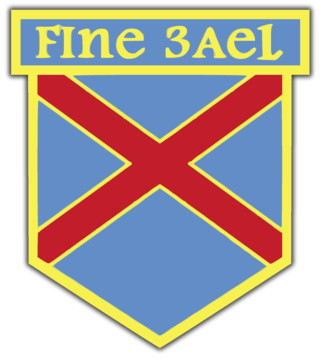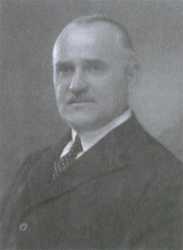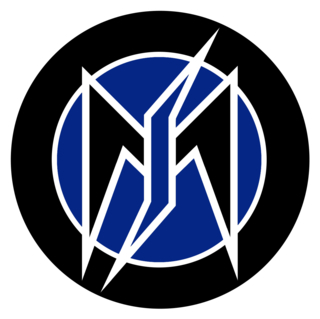
The Sturmabteilung was the original paramilitary wing of the Nazi Party. It played a significant role in Adolf Hitler's rise to power in the 1920s and 1930s. Its primary purposes were providing protection for Nazi rallies and assemblies, disrupting the meetings of opposing parties, fighting against the paramilitary units of the opposing parties, especially the Roter Frontkämpferbund of the Communist Party of Germany (KPD) and the Reichsbanner Schwarz-Rot-Gold of the Social Democratic Party of Germany (SPD), and intimidating Romani, trade unionists, and especially Jews.

The British Union of Fascists (BUF) was a British fascist political party formed in 1932 by Oswald Mosley. Mosley changed its name to the British Union of Fascists and National Socialists in 1936 and, in 1937, to the British Union. In 1939, following the start of the Second World War, the party was proscribed by the British government and in 1940 it was disbanded.

The Army Comrades Association (ACA), later the National Guard, then Young Ireland and finally League of Youth, but best known by the nickname the Blueshirts, was a paramilitary organisation in the Irish Free State, founded as the Army Comrades Association in Dublin on 9 February 1932. The group provided physical protection for political groups such as Cumann na nGaedheal from intimidation and attacks by the IRA. Some former members went on to fight for the Nationalists in the Spanish Civil War after the group had been dissolved.

The Social Credit Party of Great Britain and Northern Ireland was a political party in the United Kingdom. It grew out of the Kibbo Kift, which was established in 1920 as a more craft-based alternative for youth to the Boy Scouts.
Fascist symbolism is the use of certain images and symbols which are designed to represent aspects of fascism. These include national symbols of historical importance, goals, and political policies. The best-known are the fasces, which was the original symbol of fascism, and the swastika of Nazism.
The term "Blue Shirts", when used by itself, can refer to several organizations, mostly fascist organizations found in the 1920s and 1930s.
The National Corporate Party was a fascist political party in Ireland founded by Eoin O'Duffy in June 1935 at a meeting of 500. It split from Fine Gael when O'Duffy was removed as leader of that party, which had been founded by the merger of O'Duffy's Blueshirts, formally known as the National Guard or Army Comrades Association, with Cumann na nGaedheal, and the National Centre Party. Its deputy leader Colonel P.J. Coughlan of Cork. Its secretary was Captain Liam D. Walsh of Dublin.

Zoltán Meskó de Széplak was a leading Hungarian Nazi during the 1930s. He led his own Nazi movement during the early 1930s but faded from the political scene when Hungary became a member of the Axis powers.
Blackshirts were originally the paramilitary wing of the Kingdom of Italy.
Fascist movements gained popularity in many countries in Asia during the 1920s.
A fascist paramilitary is a fighting force - whether armed, unarmed, or merely symbolic - that is independent of regular military command and is established for the defence and advancement of a movement that adheres to the radical nationalist ideology of fascism. Since fascism is such a militarist ideology, there are very few varieties of fascism where paramilitaries do not play a central role, and some kind of paramilitary participation is almost always a basic requirement of membership in fascist movements. Fascist paramilitaries have seen action in both peacetime and wartime. Most fascist paramilitaries wear political uniforms, and many have taken their names from the colours of their uniforms.
Greenshirts or Green shirts can mean:
This is a list of words, terms, concepts, and slogans in the Italian language and Latin language which were specifically used in Fascist Italian monarchy and Italian Social Republic.
Neil Lanfear Maclean Francis Hawkins was a British writer and politician who was a leading proponent of British fascism in the United Kingdom both before and after the Second World War. He played a leading role in the British Union of Fascists and controlled the organisational structure of the movement.

The Voluntary Militia for National Security, commonly called the Blackshirts or squadristi, was originally the paramilitary wing of the National Fascist Party, known as the Squadrismo, and after 1923 an all-volunteer militia of the Kingdom of Italy under Fascist rule, similar to the SA. Its members were distinguished by their black uniforms and their loyalty to Benito Mussolini, the Duce (leader) of Fascism, to whom they swore an oath. The founders of the paramilitary groups were nationalist intellectuals, former army officers and young landowners opposing peasants' and country labourers' unions. Their methods became harsher as Mussolini's power grew, and they used violence and intimidation against Mussolini's opponents. In 1943, following the fall of the Fascist regime, the MVSN was integrated into the Royal Italian Army and disbanded.

The Blue-and-Blacks (Sinimustat) was a fascist youth organization that operated in Finland from 1930 to 1936, initially affiliated with the Lapua movement and then the Patriotic People's Movement (IKL).
The Battle of Carfax (1936) was a violent skirmish in the city of Oxford between the British Union of Fascists (BUF) and local anti-fascists, trade unionists, and supporters of the Labour Party and the Communist Party of Great Britain. The battle took place inside Oxford's Carfax Assembly Rooms, a once popular meeting hall owned by Oxford City Council which was used for public events and located on Cornmarket Street.

The Blueshirt, often worn with a red scarf, serves as the traditional attire for members of various youth organizations with roots in the socialist and labor movements. It is the distinctive outfit for members of the German Falcon organization, the Austrian Red Falcons, and the Socialist Youth Austria (SJÖ). The blue shirt symbolizes the connection to the labor movement, while the red scarf reflects their affiliation with socialism or social democracy. The tradition of wearing a blue shirt originated with the Red Falcons in 1920s Austria.








